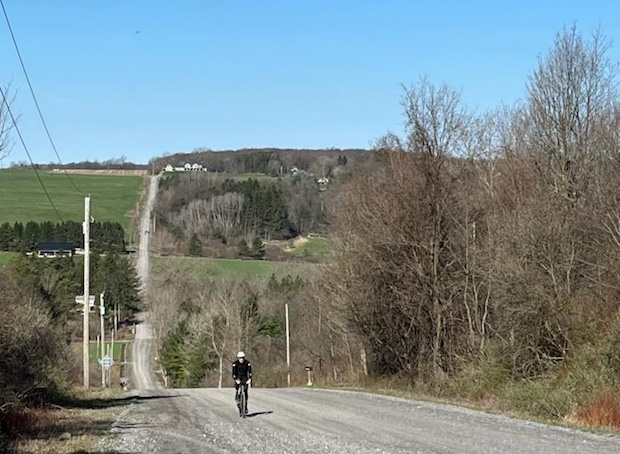Challenge Getaway HTLR Tire Review
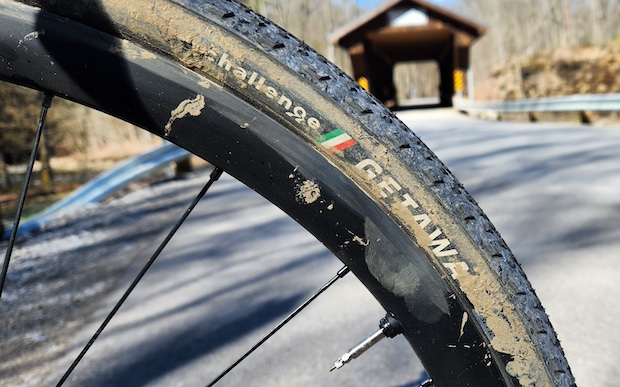
When first considering Challenge tires, the most important characteristic to know is the difference between their handmade and vulcanized tires. There are tradeoffs between the two.
Challenge’s handmade tires use high TPI (e.g., 260) casing materials and natural rubber that give the tire soft and supple characteristics. These tires feel better than the vulcanized tires because the suppleness conforms more easily to the terrain. However, the trade-off is that the natural rubber of the tread is stickier and wears faster than vulcanized rubber. The supple sidewalls are also arguably more susceptible to sidewall cuts than the more durable vulcanized alternatives.
Challenge’s vulcanized tires use lower TPI (e.g., 120) nylon casings impregnated with butyl rubber which makes them stiffer and arguably less comfortable than the handmade tires. Vulcanized tires come in the typical U shape that most consumers are accustomed to, as opposed to the handmade tires that are made flat. While the stiffness of a vulcanized tire may not perform and feel as well as their handmade tires, the tradeoff is a more durable tire with longer tread life and less susceptibility to sidewall cuts.
This characterization of the differences between Challenge’s handmade and vulcanized offerings is a bit over-simplified as there are additional design features to consider, but this characterization provides a general orientation to the differences.
Pet Peeve
Before gravel became GRAVEL, we rode many of the same gravel roads on our road or cyclocross bikes. As gravel evolved into its own riding and racing discipline, the tires began to trend larger and the pressures began to trend lower. For a good stretch of time, many of us were running 30 to 35 mm tires on our cyclocross bikes because that was the maximum tire size those frames could fit. Though many of us were running handmade tubulars for cyclocross racing, we sought out tubeless wheelsets and tires for gravel riding and racing because the tires could be repaired roadside.
Those early 30-40 mm tubeless gravel tires came vulcanized and rode ok across smooth dirt and chunky gravel roads. However, in any circumstances that you needed to ride in off-camber terrain and use the edge of the tire, they were largely worthless and left you sliding out. For lack of a better term, these early gravel tires were boxy and had little to no suppleness that would allow the tire to perform well on its edges. At the time, the tradeoff was durability at the cost of suppleness. Less flats but the tires felt like you were riding on a garden hose.
As a result, there was a pretty hard distinction between tires that were durable and good for level gravel roads compared to tires that were more fragile and good for mixed terrain including off-camber sections. At races like Paris to Ancaster in Ontario, Canada, which features pavement, gravel, bike path, singletrack, and cyclocross sectors in farm fields, tire choices were made across these hard distinctions of durability vs. performance in mixed terrain.
From those years, I’ve had a pet peeve with “gravel” tires that are largely worthless as soon as you get them off road or in mixed terrain.
Immediately Curious
As a long-time user of Challenge tubulars for cyclocross, I had all kinds of questions about Challenge’s handmade tubeless offerings for gravel. How would they make a handmade casing that would be sealed for tubeless? How would this handmade casing improve road feel and off-camber compliance? How durable would the sidewalls be of these handmade casings?
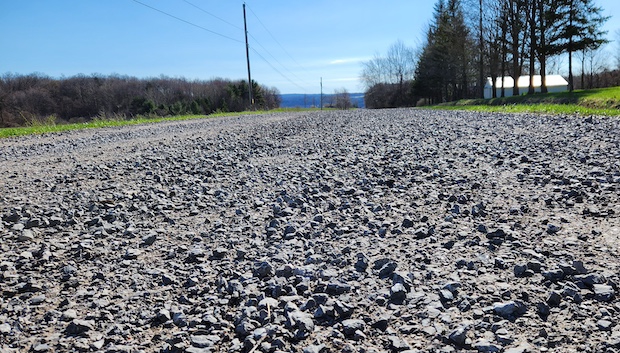
To answer my questions, I put a pair of 40mm Challenge Getaways Handmade Tubeless (HTLR) to the test. To date, I have 175 miles on them riding on pavement, gravel, and mixed terrain. Our gravel in Western New York is a mixture of dirt hardpack and medium chunky gravel that gets spread in the spring to remediate rural dirt roads. By mixed terrain, I’m referring to the labyrinth of bandit ATV trails and abandoned rail lines in our post-industrial playground of Buffalo, NY.
Mounting
The Challenge HTLR tires take some care when mounting. First, they fit tight; really tight on some rims. Keep in mind that the casings are handmade and meant to be supple. As a result there is a risk that if you horse these tires and force them on the rim, you could stretch the bead and damage the shape of the tire. I have heard of this happening in at least one case. In another case, I heard of someone who gave up on mounting these tires, deciding they were incompatible with the rims they were using.
My theory is that these issues in mounting were due to improper technique. Historically, I think many of us are used to starting at the valve and working our way around to the other side of the rim to mount the tire. In the case of these Challenge HTLRs (and most tubeless tires), you will want to do the opposite. Start mounting the tire at the opposite end from the valve and work your way toward the valve. The key is to decrease the circumference of the rim that you are mounting the tire on. You accomplish this by making sure the bead is sitting in the lowest recess of the rim bed as you work your way around. Starting at the valve only increases the circumference because the tubeless valve doesn’t allow the tire bead to sit down in the lowest recess of the rim bed.
Challenge offers a tool for mounting their clincher and tubeless tires, but I didn’t need the tool and was able to mount the Getaway HTLRs on a set of Shimano RX880 hooked carbon wheels that have an internal width of 25mm. I used a wide Pedros tire lever to pop the last part of the bead over the rim by the valve. I then removed the valve core and seated the tire with an air compressor.
I decided to try Challenge’s tire sealant that I injected through the valve stem. Challenge recommends using their own sealant, of course. However, I haven’t heard of any reason why you couldn’t use a different sealant. I’m not aware of any adverse interactions between other sealants and Challenge’s handmade casings.
Ride Feel
For tire pressure, I used the Silca tire pressure calculator minus 1-2 psi. There’s nothing particularly authoritative about Silca’s tire pressure calculator in my view, in fact I find it runs a bit high for my riding preferences. However, I cite it here as a shared metric to contextualize my review for your own weight and terrain. For comparison, I’ve been running a few other 40mm vulcanized gravel tires at the same pressure.
In short, Challenge’s HTLR tires feel like a tire should feel like. I really value being able to use the whole tire, especially on mixed terrain without worry that the tire will “tip over” when put on its edges and not conform to any surface that isn’t level.
The Getaway HTLRs feel good and compliant when blasting over chunky gravel, no issues there. But where I find they really shine is when you find yourself riding out a rut and coming in contact with the sides of that rut. You never want to fight a rut. They are best riding out, unless you can hop your way out. In Western New York, I find myself in ruts often at high speeds caused by either ATV tires or water run off downhill. With the vulcanized gravel tires I’ve run, these ruts don’t leave much margin for error because you can quickly lose traction at the edges. However, with the more supple sidewalls of the Challenge Getaway HTLRs I can be more playful within those ruts and expect that the tire will conform to the sides of the rut. Get too cocky though, and those ruts will for sure put you on your butt. Gotta respect the ruts.
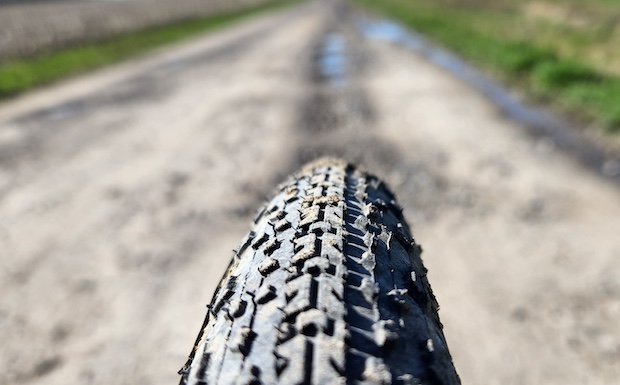
In my experience, with that suppleness of the HTLRs comes confidence. I can have confidence in the tire that it won’t slip out immediately if I put it on its edges. However, the Getaway is no cyclocross tire. The side knobs are not aggressive enough to hook really loose or muddy terrain. Therefore, it’s good to keep in mind that the Getaway is a gravel tire first and foremost.
Depending on the weather, the Getaway is going to be my tire of choice for Paris to Ancaster this year. It does everything a gravel tire should and more, and I believe that if not too muddy it can handle the cyclocross sectors of that race course.
Durability
As I said before, there are trade-offs with the suppleness of the HTLR casing. Though the tire gave me confidence in the ride feel, I did have some hesitation when it came to the durability of the sidewalls. The natural rubber material is more susceptible to sidewall cuts compared to a vulcanized tire.
For this review, though, I decided to throw caution to the wind and test the tires out on the gnarliest gravel we have in Western New York. We have long stretches of abandoned and unused railroad bed, some of which is now slowly (very slowly due to funding and property negotiations) being resurfaced for multi-use recreation. The untouched railroad beds are surfaced with railroad ballast, which is large, chunky, and often sharp. Outside of the context of this review, I would never consider taking carbon rims and a handmade tire on these stretches. But for the sake of testing, I let it rip full gas on a few of these sectors of railroad ballast. The picture below is my son riding on one of the less aggressive ballast sectors.
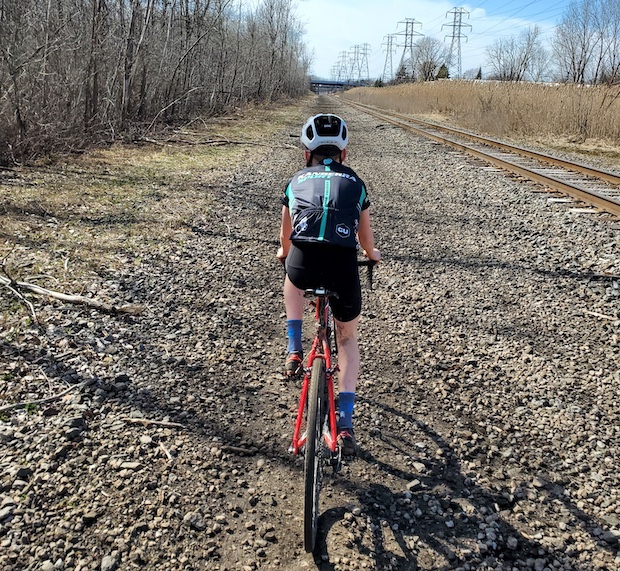
Expecting the worst, I was surprised to only experience the most minor of sidewall gashes. Keep in mind that most people riding and racing in the context of gravel are not going to be riding on railroad ballast, so this was a bit of an extreme and unfair test for the tires.
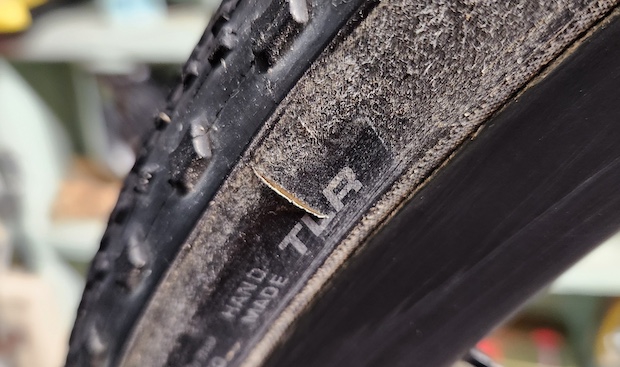
That being said, Challenge recently released the XP version of the Getaway. XP refers to Xtra Protection in the sidewalls. The XP tires add a special layer of tightly woven material (Corazzaarmor Silver and Gold) that reinforces it for more aggressive conditions. This model promises to be less permeable to sidewall cuts compared to the standard handmade Getaway. This may be the option you will want to seek out if you are riding in conditions akin to railroad ballast. The question is how much the extra material will change the suppleness of the tire. My guess is that it will still feel better than a vulcanized tire.
Challenge Tire Gravel Line Up
Challenge offers five tire treads of varying widths and materials in their gravel line. Here’s a quick round up of those offerings and where the Getaway HTLR falls in that line up in order from least to most aggressive. However, not every variation is available across these characteristics.
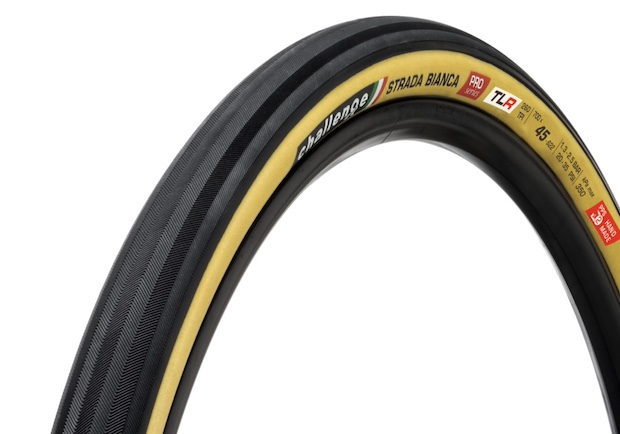
Tire: STRADA BIANCA
Tread: Herring bone pattern
Material: Natural Rubber/Handmade, Vulcanized, or Silk
Type: Clincher, Tubeless, Tubeless Tubular
Sidewall Color: Tan, Black
Sizes: 30, 33, 36, 40mm (also 650 x 46mm)
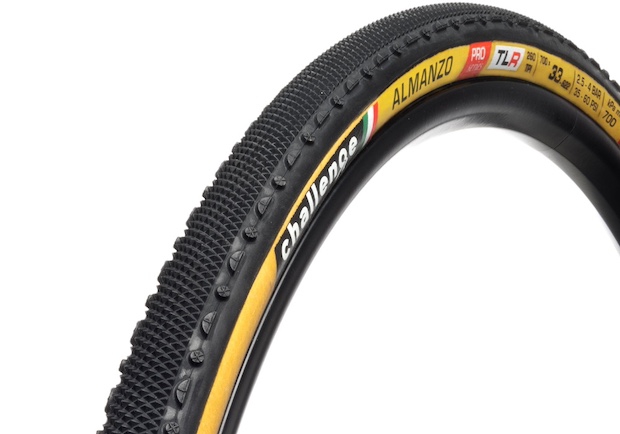
Tire: ALMANZO
Tread: Diamond pattern with Grifo-inspired side knobs
Material: Natural Rubber/Handmade
Type: Clincher, Tubeless, Tubular, Tubeless Tubular
Sidewall Color: Tan
Size: 33mm
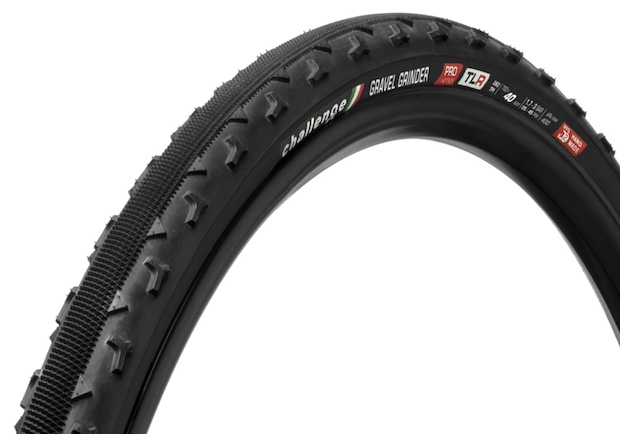
Tire: GRAVEL GRINDER
Tread: Diamond pattern with Limus-inspired side knobs
Material: Natural Rubber/Handmade or Vulcanized
Type: Clincher, Tubeless, Tubular, Tubeless Tubular
Sidewall Color: Tan or Black
Sizes: 33, 36, 38, or 42mm
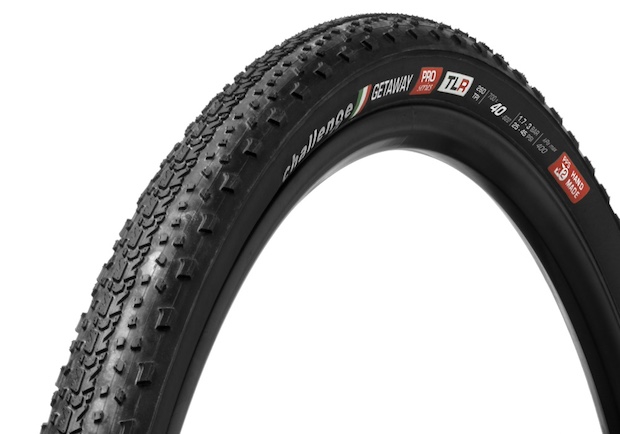
Tire: GETAWAY
Tread: Low profile tread with medium side knobs
Material: Natural Rubber/Handmade
Type: Clincher, Tubeless, or Tubeless Tubular
Sidewall Color: Tan or Black
Sizes: 36, 40, or 45mm
XP (Xtra Protection) Option in 40 and 45mm Black
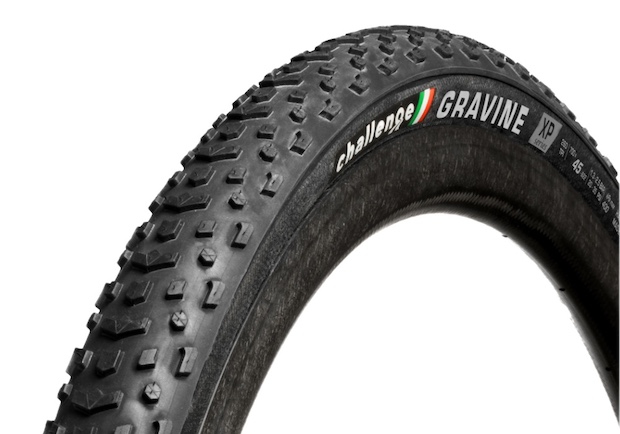
Tire: GRAVINE
Tread: Higher profile tread with higher side knobs
Material: Natural Rubber/Handmade
Type: Tubeless
Sidewall Color: Tan or Black
Sizes: 40 or 45mm
XP (Xtra Protection) Option in 40 and 45mm Black
Options
Hopefully, this review gives you some insight into the range of offerings from Challenge. There are many more variations to consider compared to other tire companies. Here is my suggestion for the order in which you may want to consider these many options.
First, consider what type of tire you want to run on your gravel bike. For most people that will be a choice between Clincher and Tubeless.
Second, consider what tread will be best for the terrain you plan on riding. I suggest the Getaway for most gravel riding and the Gravine if you need something more aggressive.
Third, consider size. Bigger seems to be better, so you may want to go as big as your frame will allow. I’ve been slow to adapt to this trend and find that 40mm is the sweet spot for me right now, even though my frame can accommodate 45mm tires.
Fourth, consider the material tradeoffs between Handmade and Vulcanized. For friends who are closely attuned to the feel of their tires, I suggest the natural rubber of handmade. For friends who don’t want to think about their tires much at all and just want them to stay inflated, I suggest vulcanized. Consider the XP options in the Getaway and Gravine tires if you are worried about sidewall durability.
Lastly, consider sidewall color. This is a very personal decision. I am and always will be a black sidewall kind of guy. If you see me with tan sidewalls, it wasn’t by choice. For some people this decision very may well be their first criteria. I ride with a few tan sidewall hardliners who are willing to sacrifice performance for aesthetics.
In conclusion, keep an eye on Challenge as they offer more variations within their gravel tire lineup. They are quick to pivot to meet market demands and rider preferences.
Challenge tires can be purchased through the Slowtwitch retail shop.
